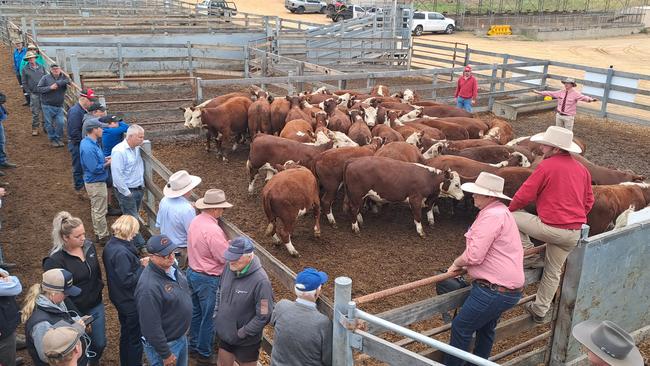Calf breeders fight higher costs of production
Amid healthy weaner sale results, calf breeders may still be struggling to making a reasonable profit margin considering higher costs of production and elevated land values.
Good money, not enough money and too much money – all three phrases have some legitimacy in terms of how the opening new year calf sales have played out in Victoria.
Angus weaner steers have averaged a ballpark 400-425c/kg liveweight at feature sales at Wodonga, Naracoorte in SA, Yea and Wangaratta in the past week.
It is a better result than was anticipated after a tough lead in during December when the prime cattle market struggled and seasonal conditions remained difficult, particularly in the south.
In dollar-a-head terms the January sales have been a good $100 to $200 better than many selling agents had dared dream of just a few weeks ago.
Store calves at 400c/kg-plus is good money compared to the current ruling rate for finished bullocks and feeder steers. Agents advise the ballpark money from processors at present for prime bullocks is about 700c/kg dressed, which breaks down to the equivalent of 385c/kg liveweight.
And that money is for the better quality finished steers. There is still a lot of steers making from 330c/kg to 380c/kg at prime markets where breed and quality tends to be more mixed. A case in point was the Mortlake prime cattle sale on Monday where the average price for Angus and Angus-cross steers was 335c/kg (across all weights and grades), according to data from OutCross.
So a premium of 400c/kg-plus for weaner steers over the reality that a lot of finished and feeder cattle are selling for less than this has to be considered a good result. Admittedly, the industry has seen periods where the price difference between stores and finished animals has been a lot wider, but taking into account the lack of feed and water in the south, the fragile confidence level of producers after a torrid 18-months, it can be argued that calves are selling pretty well.
However, when you drill down into the figures there is also the argument that calf breeders are still struggling to making a reasonable profit margin considering today’s higher costs of production and elevated land values.
To use the opening Yea weaner sale as a benchmark. Last Friday this sale averaged $1207 across the feature yarding of steers and heifers. The year before it was $907, according to saleyard records.
So in the past two years the average return for vendors selling steer and heifer calves at this feature weaner sales has been $1057. Take out selling costs, yard fees, agents commission, transport in, and the take home average would be less than $1000 a head.
Throw in the 2023 average of $1627 and it does boost the income average for vendors at Yea to $1247 before selling costs. But while the industry loves to talk about five and 10 year trends, the reality for a lot of producers it has been a tight run for the past couple of seasons, particularly for those who have experienced droughts and floods leading to significant feed costs.

It was interesting to hear an agent make a comment this week that the feedback he was getting from clients was they needed around $1300 to break even otherwise they were “really just doing it for fun” after input cost increases for things like chemicals, sowing, diesel, machinery and equipment, genetic bull power, fencing, higher bank interest rates and labour.
The idea that this year’s calf sales are a big win for producers is not really accurate, although the price improvement is a step in the right direction from a year ago.
Now to flip the argument to the buyers side. As detailed in market reports it has been NSW and Queensland buyers which have underpinned prices at the sales.
And these buyers face significant transport costs of $50 to well over $100 a head to land these calves home.
One buyer candidly went through some ballpark figures for steer calves purchased that were destined for a backgrounder in Central West NSW. He said the load of steer calves had averaged close to $1400 a head, as they needed to be the top end as the producer was aiming for a late winter turn-off. Costs including freight would add close to another $100, meaning the steers would owe $1500 before feed costs during the next six months.
The buyer said if the feeder market remained at current levels there would be a slim gross margin of only a few hundred dollars per steer in the trade. The hope was the market could improve to 420c/kg to 450c/kg to create a decent margin.
There has to be a component of anticipation in the Australian cattle market continuing to ramp up on the back of record beef prices in the US, and the low Australian dollar. Because as mentioned above, on current levels, the calf market looks dear enough for some of these buyers.




